
Knowing the stages helps entrepreneurs anticipate what's ahead. Each phase comes with its unique challenges and opportunities. Awareness of these stages allows business owners to mentally, emotionally, and strategically prepare, reducing the shock factor and enabling more effective decision-making.
Different stages demand different resources. By understanding the phases, business owners can allocate their budget, time, and staffing more effectively. For instance, early stages might require product development and validation investment, while later stages may necessitate funds for scaling operations and marketing.
A roadmap based on the stages helps in creating a well-thought-out business strategy. Entrepreneurs can set short-term and long-term goals, determine critical milestones, and plan how to tackle obstacles that commonly arise in each phase.
Startups often stumble into common traps. For example, not adapting to changing market needs can lead to failure. Knowing these stages helps entrepreneurs recognize warning signs and pitfalls that others have fallen into, making them more likely to avoid them. Different stages require different skill sets and sometimes different people.
The journey from conception to success in startup businesses is comparable to navigating a dense and treacherous jungle. This metaphor aptly captures the myriad challenges, uncertainties, and exhilarating moments that entrepreneurs encounter during various phases of their startup ventures. Just as the jungle is a realm of danger and beauty, startups also experience diverse experiences as they progress through their jungle phases.
**1. Conception - The Seedling Stage
Every startup begins as a tiny seedling of an idea planted in the fertile soil of an entrepreneur's mind. The germination phase is where concepts get brainstormed, and possibilities are explored. It's a period of enthusiasm, curiosity, and cautious optimism. Like a seedling stretching towards the sunlight, entrepreneurs formulate their vision, identifying market gaps and opportunities.
**2. Birth - The Sprouting Stage
As the idea takes root, the startup enters the sprouting stage. This stage is the moment of inception when the concept transforms into a tangible entity. Entrepreneurs create a business plan outlining their strategy, target audience, and value proposition. The sprouting stage is crucial, as it sets the foundation for growth. As a young sapling needs nurturing care, startups require careful planning and resource allocation.
**3. Growth - The Canopy Stage
The canopy in the jungle is the lush upper layer of vegetation where rapid growth and competition are fierce. Similarly, the growth phase is marked by rapid expansion, attracting attention from customers, investors, and competitors. Scaling up operations, refining products or services, and building a solid team are essential to this phase. Like vines reaching for sunlight, startups strive to reach new heights, often encountering unexpected hurdles.
**4. Turbulence - The Stormy Weather Stage
Jungles are notorious for their unpredictable weather, and startups face storms in the form of setbacks and challenges. Economic downturns, regulatory hurdles, and internal conflicts can threaten to uproot the progress made so far. This turbulence is a make-or-break phase, testing an entrepreneur's resilience and adaptability. Just as trees with strong roots weather the fiercest storms, startups with solid foundations can endure and even emerge stronger.
**5. Adaptation - The Darwinian Stage
Survival in the jungle requires adaptation to changing conditions. Similarly, startups must pivot and evolve based on market feedback and shifting trends. This phase demands introspection, learning from failures, and aligning strategies with new insights. Startups that successfully adapt are better equipped to navigate the ever-evolving business landscape.
**6. Maturity - The Thriving Ecosystem Stage
As a startup matures, it establishes its presence in the market and achieves stability. Just as a diverse ecosystem thrives in the jungle, a successful startup develops a sustainable business model, loyal customer base, and consistent revenue streams. Expansion into new markets and diversification of offerings can further enhance the startup's resilience and longevity.
**7. Innovation - The Biodiversity Stage
Jungles are known for their biodiversity, and established startups foster a culture of innovation. This phase involves exploring new avenues, experimenting with novel ideas, and staying ahead of competitors. Continued innovation ensures the startup remains relevant and captures the market's attention.
**8. Legacy - The Evergreen Stage
In time, startups that have persevered and flourished achieve a state of evergreen legacy. As towering trees leave a lasting imprint on the jungle, these businesses leave their mark on the industry and inspire the next generation of entrepreneurs. Whether through transformative products, positive societal impact, or influential leadership, the legacy phase symbolizes the culmination of a remarkable journey.
The jungle phases of startup businesses mirror the wilderness's intricate, dynamic, and unpredictable nature. Each stage has unique challenges and opportunities, testing an entrepreneur's determination and strategic insight. Like explorers in the jungle, startup founders must navigate uncharted territories, adapt to changing landscapes, and harness their inner strengths to emerge triumphant. Just as the jungle rewards those who persevere with hidden treasures, the world of startups promises success to those who dare to venture and thrive in its wild terrain.
The stages provide a framework that helps entrepreneurs navigate the unpredictable journey of building a business. While every startup's journey is unique, the commonalities among these stages provide a roadmap tailored to each business's specific circumstances. This understanding enhances the likelihood of making informed decisions, overcoming challenges, and achieving the desired growth and success.